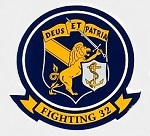Forces of Valor 85040 US Navy Grumman F-14A Tomcat Fleet Defense Fighter - VF-32 "Fighting Swordsmen", USS John F. Kennedy (CV-67), 1989 [Low-Vis Scheme] (1:72 Scale)
"Obsolete weapons do not deter."
- British Prime Minister Margaret Thatcher
 The F-14 Tomcat program was initiated when it became obvious that the weight and maneuverability issues plaguing the U.S. Navy variant of the Tactical Fighter Experimental (TFX) (F-111B) would not be resolved to the Navy's satisfaction. The Navy requirement was for a fleet air defense fighter (FADF) with the primary role of intercepting Soviet bombers before they could launch missiles against the carrier group. The Navy also wanted the aircraft to possess inherent air superiority characteristics. The Navy strenuously opposed the TFX, which incorporated the Air Force's requirements for a low-level attack aircraft, fearing the compromises would cripple the aircraft, but were forced to participate in the program at direction of then Secretary of Defense Robert McNamara who wanted "joint" solutions to the service aircraft needs to reduce developmental costs. The prior example of the F-4 Phantom which was a Navy program later adopted by the USAF (under similar direction) was the order of the day. Vice Admiral Thomas Connolly, DCNO for Air Warfare took the developmental F-111A for a flight and discovered it was unable to go supersonic and had poor landing characteristics. He later testified to Congress about his concerns against the official Department of the Navy position and in May 1968, Congress killed funding for the F-111B allowing the Navy to pursue an answer tailored to their requirements.
The F-14 Tomcat program was initiated when it became obvious that the weight and maneuverability issues plaguing the U.S. Navy variant of the Tactical Fighter Experimental (TFX) (F-111B) would not be resolved to the Navy's satisfaction. The Navy requirement was for a fleet air defense fighter (FADF) with the primary role of intercepting Soviet bombers before they could launch missiles against the carrier group. The Navy also wanted the aircraft to possess inherent air superiority characteristics. The Navy strenuously opposed the TFX, which incorporated the Air Force's requirements for a low-level attack aircraft, fearing the compromises would cripple the aircraft, but were forced to participate in the program at direction of then Secretary of Defense Robert McNamara who wanted "joint" solutions to the service aircraft needs to reduce developmental costs. The prior example of the F-4 Phantom which was a Navy program later adopted by the USAF (under similar direction) was the order of the day. Vice Admiral Thomas Connolly, DCNO for Air Warfare took the developmental F-111A for a flight and discovered it was unable to go supersonic and had poor landing characteristics. He later testified to Congress about his concerns against the official Department of the Navy position and in May 1968, Congress killed funding for the F-111B allowing the Navy to pursue an answer tailored to their requirements.
NAVAIR shortly issued an RFP for the Naval Fighter Experimental (VFX), a tandem two-seat fighter with maximum speed of Mach 2.2 and a secondary close air support role. Of the five companies that submitted bids (four of which incorporated variable-geometry wings as on the F-111), McDonnell Douglas and Grumman were selected as finalists in December 1968, and Grumman won the contract in January 1969. Grumman had been a partner on the F-111B, and had started work on an alternative when they saw the project heading south, and so had an edge on its competitors. Their early design mock-ups and cost projections were floated among Navy brass as an alternative to the F-111B.
The winning Grumman design reused the TF30 engines from the F-111B, though the Navy planned on replacing them with the F401-PW-400 engines then under development by Pratt and Whitney for the Navy (in parallel with the related F100 for the USAF). Though lighter than the F-111B, it was still the largest and heaviest U.S. fighter to ever fly from an aircraft carrier, its size a consequence of the requirement to carry the large AWG-9 radar and AIM-54 Phoenix missiles, also from the F-111B and an internal fuel load of 16,000 lbs (7300 kg). The F-14 would also share a similar inlet duct, wing, and landing gear geometry with Grumman's A-6 Intruder.
The F-14 first flew on December 21st, 1970, just 22 months after Grumman was awarded the contract, and reached Initial Operational Capability (IOC) in 1973. While the Marine Corps was interested in the F-14 and went so far as to send pilots to VF-124 to train as instructors, they were never fully sold on the aircraft and pulled out when the stores management system for ground attack munitions was left undeveloped, leaving the aircraft incapable of dropping air-to-ground munitions (these were later developed in the 1990s).
Pictured here is a gorgeous 1:72 scale diecast replica of a USN F-14A Tomcat then embarked upon the USS John F. Kennedy during 1989.
Sold Out!
Dimensions:
Wingspan: 7 inches
Length: 10.5 inches
Release Date: May 2014
 Historical Account: The "Fighting Swordsmen" - The "Fighting Swordsmen" of Strike Fighter Squadron THIRTY-TWO (VFA-32) are a United States Navy strike fighter squadron presently flying the F/A-18F Super Hornet and based ashore at Naval Air Station Oceana. Their radio callsign is Gypsy and their tail code is AC.
Historical Account: The "Fighting Swordsmen" - The "Fighting Swordsmen" of Strike Fighter Squadron THIRTY-TWO (VFA-32) are a United States Navy strike fighter squadron presently flying the F/A-18F Super Hornet and based ashore at Naval Air Station Oceana. Their radio callsign is Gypsy and their tail code is AC.
Their mission is: "Strike Fighter Squadron THIRTY-TWO, as a part of United States Naval Aviation, utilizes the F/A-18F aircraft to project power ashore and at sea, to defend the Fleet against air and sea threats and to carry out all other missions which may be assigned by cognizant authority."
Two distinct squadrons have been designated VF-2.The first VF-2 was established on 1 June 1943 and was disestablished on November 13th, 1945. The second VF-2 eventually became VFA-32.









